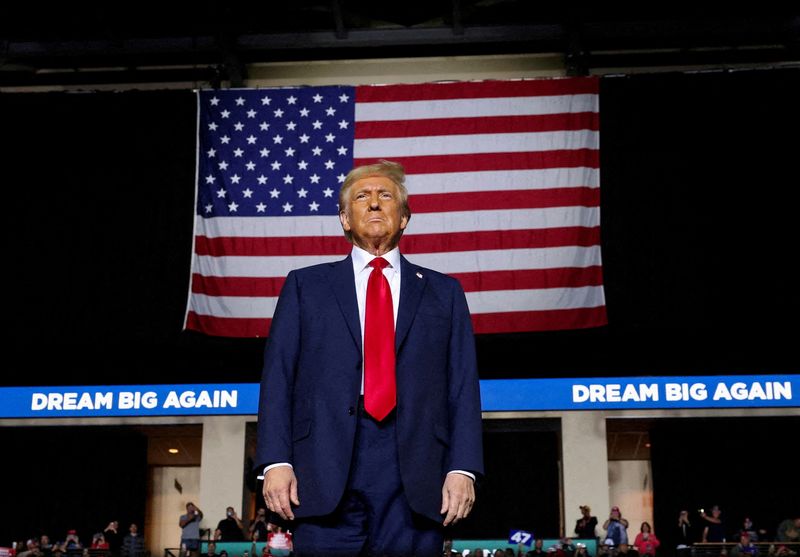By Andy Sullivan
WASHINGTON (Reuters) – When President-elect Donald Trump’s Republicans take control of the U.S. Congress next month, they plan to rely on a maneuver called “reconciliation” to achieve his ambitious tax-cutting and border-hardening goals over the opposition of Senate Democrats.
Here is an explanation of how that works:
WHAT IS RECONCILIATION?
The U.S. Senate’s “filibuster” rule requires 60 votes in the 100-seat chamber to advance most legislation. Republicans will start next year with a 53-47 Senate majority, which would require seven Democrats to vote with them to pass bills.
However, reconciliation allows some tax and spending bills to pass with a simple majority vote. Republicans plan to use this process to increase spending on border security and cut taxes, and are currently deciding whether to handle them separately or roll them into one gigantic package.
Republicans will also control the House of Representatives by a 220-215 margin when all their seats are filled, but can pass legislation with a simple majority vote in that chamber.
HOW CAN RECONCILIATION BE USED?
Reconciliation was set up to make it easier for Congress to control the U.S. government’s finances, and is supposed to be used only for budget-related legislation: taxes, spending and raising the debt limit.
It can’t be used to pass legislation that doesn’t have a significant impact on the budget.
Changes to the Social Security retirement program are specifically excluded, and a reconciliation bill cannot increase budget deficits over the long term.
Senators can also force a vote to remove elements they think do not fit.
These rules prevented Democrats from raising the national minimum wage when they passed a $1.9 trillion COVID-19 relief package through reconciliation in 2021, and prevented Republicans from loosening health insurance regulations when they unsuccessfully tried to repeal the Affordable Care Act health law through reconciliation in 2018.
Lawmakers have sometimes found workarounds. Trump’s 2017 tax cuts will expire at the end of 2025 to avoid increasing long-term budget deficits, for example, but Republicans will try to extend them.
Next (LON:NXT) year, Republicans will probably be able to use reconciliation to increase spending on border enforcement, but not to change the process for obtaining U.S. citizenship.
HOW HAS RECONCILIATION BEEN USED IN THE PAST?
Reconciliation was created by the Congressional Budget Act of 1974 and first used for a budget bill signed into law by Democratic President Jimmy Carter in 1980.
Congress used reconciliation to enact much of Republican President Ronald Reagan’s economic agenda in the 1980s, which included tax cuts, military spending increases and cuts to domestic spending.
In the 1990s, it was used to pass bipartisan deals that raised revenue and cut spending, helping the federal government balance its budget at the turn of the century. Reconciliation was also used to overhaul welfare programs in 1996.
As Washington’s partisan divides have deepened, leading to congressional gridlock during periods of divided government, Republicans and Democrats have used reconciliation to push their agendas through.
Democratic President Joe Biden’s major legislative wins – including a $1 trillion infrastructure bill – was passed this way, as were Trump’s 2017 sweeping tax cuts.
Reconciliation has been used 23 times in total.
HOW WOULD IT WORK?
Republicans would first have to pass a budget resolution, which sets annual tax and spending levels. Congress is supposed to do this every year, but has only done so nine times over the past 20 years – typically when they want to bypass partisan opposition.
It’s easy to understand why lawmakers would skip this step. Reaching agreement on taxes and spending is difficult in most years, and especially hard when control of Congress is divided between the two parties, as it is now.
Aside from setting broad spending and revenue levels, the budget resolution also dictates what can be included in the reconciliation package.
For example, it could call for $500 billion in increased revenues over the coming 10 years, and tell lawmakers on the tax-writing committees to write a bill that would raise taxes by that amount. The resulting tax bill would then be eligible to bypass the Senate’s filibuster.
Before the reconciliation bill comes up for a vote, lawmakers typically consult with the Senate parliamentarian – an authority on the chamber’s arcane procedures – to ensure it stays within the restrictions outlined above.
On the Senate floor, lawmakers can force a vote on any element they think does not fit. If the challenge, known as a “point of order,” gets more than 40 votes, the provision is struck from the bill.
Once the reconciliation package passes both the House and the Senate, lawmakers would have to resolve any differences before sending it on to be signed into law by the president.
Congress typically only enacts one reconciliation bill each year, though it has passed separate tax and spending bills several times in the past.
Sources: Congressional Research Service, Committee for a Responsible Federal Budget

